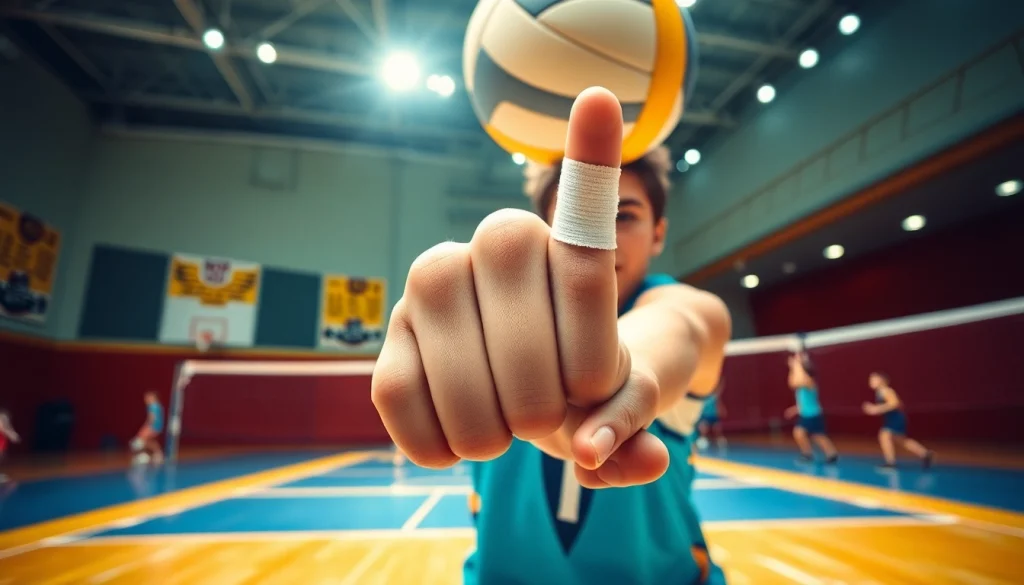Innovative Volleyball Thumb Taping Techniques for 2025: Maximize Performance

Understanding Volleyball Thumb Taping
Volleyball is an exhilarating sport that demands agility, power, and precision. However, the fast-paced nature of the game can lead to various injuries, particularly to the thumb. This is where volleyball thumb taping comes into play. It serves as a vital preventive and therapeutic measure, allowing athletes to continue performing at their best despite injuries. This article explores the intricacies of thumb taping, its benefits, and how to effectively implement this technique.
What is Volleyball Thumb Taping?
Volleyball thumb taping is a technique used to provide support and stabilization to the thumb joint during gameplay. It involves wrapping athletic tape around the thumb and wrist in specific patterns that immobilize the joint while allowing for some range of motion. This method is particularly crucial for players who have suffered from thumb injuries, such as sprains or strains, or who are at high risk of such injuries.
Benefits of Thumb Taping for Volleyball Players
Taping the thumb offers several significant benefits, including:
- Injury Prevention: Proper taping techniques can help reinforce the thumb joint, reducing the likelihood of injury during aggressive play.
- Pain Relief: Taping provides compression, which can alleviate pain and swelling while playing.
- Increased Confidence: Knowing that their thumb is protected allows players to focus on their game without fear of aggravating an existing injury.
- Enhanced Performance: Players can maintain their skills and performance levels, even with a previous injury.
Common Injuries Addressed by Taping
Thumb taping is primarily effective for addressing:
- Thumb Sprains: These occur when the ligaments in the thumb are overstretched or torn.
- Jammed Thumbs: A common injury in volleyball where the thumb is forcefully bent backward, usually during a block or dig.
- De Quervain’s Tenosynovitis: An overuse condition that causes pain around the thumb and wrist.
- Arthritis Pain: Taping can help stabilize the joint in players suffering from arthritis-related discomfort.
Preparing for Effective Thumb Taping
Choosing the Right Materials for Taping
Before starting the taping process, it’s crucial to select appropriate materials. Ideal options include:
- Athletic Tape: A strong, supportive tape that adheres well and provides firm support.
- Pre-Wrap: A thin foam layer that can be applied to prevent skin irritation from the tape.
- Adhesive Spray: This can enhance the tape’s grip, especially for players with sweaty skin.
Assessing Your Injury: When to Tape
Understanding when to use taping is crucial for effective injury management. Players should consider taping if they experience:
- Persistent pain or discomfort in the thumb.
- Recent injury to the thumb joint.
- A history of thumb injuries, particularly in high-impact situations.
Steps to Prepare Your Thumb for Taping
Preparing the thumb correctly is essential for effective taping:
- Clean the Area: Ensure the thumb and wrist are clean and dry to allow the tape to adhere properly.
- Assess Mobility: Gently move the thumb and note any pain points, which will help in positioning the tape.
- Apply Pre-Wrap (Optional): If sensitive skin is a concern, apply a layer of pre-wrap to reduce irritation.
Step-by-Step Guide to Volleyball Thumb Taping
Basic Taping Techniques for Beginners
For those new to thumb taping, here’s a simple method:
- Start by applying an anchor strip of tape at the base of the thumb, wrapping around the wrist.
- Next, create a ‘C’ shape by wrapping the tape around the thumb joint and securing it back to the anchor.
- Repeat this process with additional support strips, ensuring the tape is snug but not too tight to cut off circulation.
- Finish by securing the ends and ensuring the tape does not impede thumb movement excessively.
Advanced Techniques for Enhanced Support
For players requiring more support, consider the following advanced techniques:
- Figure-Eight Taping: This involves creating a figure-eight pattern around the thumb and wrist for enhanced stability.
- Spica Taping: This method immobilizes the thumb further by creating an additional layer around the joint.
- Multiple Anchor Points: Adding several anchor points along the wrist can prevent slippage during intense play.
Tips for Maintaining Tape During Play
To ensure that the tape stays in place throughout the game:
- Check the tape regularly for signs of loosening, especially after intense plays.
- Avoid excessive moisture and sweat which can degrade adhesive properties.
- Incorporate adhesive spray if necessary, particularly in humid conditions.
Real-World Applications and Player Testimonials
Case Studies of Successful Tapings
Many athletes have benefitted from thumb taping techniques. One notable case involved a college volleyball player who suffered recurrent thumb sprains. After adopting a figure-eight taping method, she experienced a significant reduction in pain and was able to play through the season without further injuries.
Player Testimonials on Thumb Taping Experiences
Players often report that taping provides not just physical support but also a psychological boost. One player stated, “When my thumb is taped, I feel more confident going for tough plays, knowing I have some added stability.”
Expert Opinions on Taping Methods
Sports rehabilitation specialists often advocate for thumb taping as a crucial part of injury management. They emphasize that while taping should not replace proper medical treatments, it is an invaluable tool for maintaining performance and preventing injury recurrence.
The Future of Thumb Taping Techniques in Sports
Emerging Trends in Sports Injury Prevention
As sports medicine continues to evolve, so do the techniques for injury prevention and management. The increasing focus on personalized approaches means that taping methods may adapt to fit individual player needs more effectively.
Technological Advances in Taping Products
Innovations in materials, such as elastic therapeutic tape and skin-friendly adhesives, are changing how athletes approach taping. These advancements not only enhance performance but also improve comfort during gameplay.
Predictions for Taping Techniques in 2025
Looking ahead, we can anticipate that taping techniques will become more accessible through instructional videos and apps that guide players through the taping process, ensuring that every athlete can utilize these supportive measures effectively.






